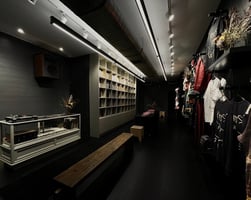Interview with Dario Calmese, Artistic Designer
-
 Hover message
Hover message
Read Jade’s conversation with designer Dario Calmese in the lead-up to Space 001’s launch at the World Trade Center.
Dario is an American creative director, photographer, and design theorist. His work interrogates the mechanisms of cultural production and the ways in which image, environment, and technology shape the lived experience. Spanning across the fields of photography, design, fashion, and performance, his practice aims at repopulating the voids within the construction of historical narrative and identity by leveraging the very systems that dictate how we come to know ourselves both collectively and individually. Read more about Dario.
Q. How did these archives come into your life?
A. These are the archives of Geoffrey Holder, a painter, singer, dancer, sculptor, choreographer…all of the above. I worked with his wife, Carmen de Lavallade. I directed and choreographed a show for her and became friends with the family. I was invited to their storage loft after Geoffrey passed in 2014. When I encountered this room full of costumes, books, and paintings, I realized that what Geoffrey left behind was a blueprint. He left behind a roadmap to creativity for all of us and so I went to work on securing the books because I wanted to create a space for other Black and Brown creatives to have access to this information.
Q. In spatial design, we often compare renderings to reality.
This space feels particularly adaptable. Have plans changed at all since opening?
A. Well, first of all, I love that you picked up on the modularity of the space. We want the space to serve multiple functions - front of house, studio, reference library, but also for programming, performances, and screenings and so we wanted something that, could shapeshift, in real-time should we need it. But yes, one has concepts and ideas, and then you get into the reality of cost, egress, and sprinkler systems, and so we've shifted some things around, but the kind of use and modularity is important.
Q. What’s coming in the next phase?
A. So what you witnessed is our listening phase – asking people what would they like to see in the space…what are their ideas? And the next phase is our opening. You'll see that we're starting to bring in items, what we're calling design artifacts, to highlight Black designers from throughout the diaspora, as well as fashion objects. We're featuring pieces from T-Michael in Norway, and a series of modular cubes designed by Mark Grattan, which will serve as both surface and seating and then we'll also start to bring out a more curated and fuller selection of the books.
Q. What was the last book you read?
A. I’m constantly reading across books. The last book I finished was Rage in Harlem: June Jordan and Architecture. This is a book that speaks about June Jordan's relationship to architecture, her love for architecture, and even some of the speculative architecture she designed in collaboration with R. Buckminster Fuller, of all people. It is by Nikhil Sehval and is the transcript of a lecture that he gave at the Graduate School of Design at Harvard.
Q. What does Black space feel like?
A. To be honest, that's what we're trying to figure out here. Another way to pose the question is, what does Black space allow for? I think that there is a type of energetics, a type of intentionality that, is part and partial and in tandem with design and space. And for so long, well, let me be clear – in contemporary Western cultures, the ability for those of us with this hue of skin...we rarely have the opportunity to manifest the concepts and ideas that we have in our head. And so in many ways, this space is doing just that – allowing us to bring it all together and begin to think about, feel, and explore the concept of what Black space allows for. What does manifested Black thought give us access to? It's not that it hasn't been done before, in many ways it exists in spaces that are not articulated, like, Paul Revere Williams with The Theme Building at LAX or Julian Abele with the Widener Library at Harvard and Duke University Chapel. But many cultural moments or movements, for example, if you talk about Italian design – begin with the concept of the Salone, bringing things all together, and then the development of the narrative...what are we speaking about? So, in many ways, this space is evoking that.
Interview was held on September 15, 2024.
Follow Dario on Instagram at https://www.instagram.com/dario.studio
Follow Black Imagination on Instagram at https://www.instagram.com/blackimagination/



